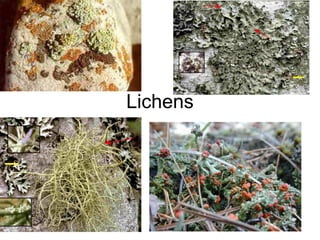
Lichens
- 1. Lichens
- 2. Lichen • An association of a fungus and a photosynthetic symbiont resulting in a stable vegetative body having a specific structure • Unique entity formed by a fungus and a photoautotroph (alga or cyanobacterium) that has characteristics that neither has alone • Widely distributed – grow on soil, rocks, trees, marine or intertidal • Variety of habitats – cold to hot, arid to moist • Withstand environmental extremes • May be dominant vegetation (e.g. tundra)
- 3. Lichens • Are primary colonizers in succession • Involved in weathering of rock and formation of soil • May exist where other organisms can’t – surface of desert rocks, alpine, arctic, etc.
- 4. Air pollution • Even though lichens are very resistant to natural environmental extremes – they are extremely sensitive to air pollution – particularly SO2 • Obtain nutrients from atmosphere, not soil • Both species composition and numbers of thalli decline from edge to center of industrialized areas • Some are useful as indicator species
- 5. Classification • Classified to species –based on morphology of fungal symbiont • Classification of the lichenized fungus • Fungal symbiont never found free-living • Are currently ca. 14,000 species of lichenized fungi • Most are in the Ascomycota – ratio of lichenized to nonlichenized Ascomycota is 14,000 : 15,000
- 6. Fungal symbiont • Most lichenized fungi are Ascomycota – most form apothecia, some form perithecia and pseudothecia • 12 orders include mostly lichenized members • Some are Basidiomycota – Aphyllophorales, few Agaricales • Some are Deuteromycota
- 7. Autotrophic symbionts • Green algae – Trebouxia is a common genus, found in 75% of lichens in temperate zone • Cyanobacteria – Nostoc is a common genus • Ca. 26 genera of algae and cyanobacteria found in lichens, 90% of lichens contain Trebouxia, Nostoc or one other genus • Autotroph may be free living
- 8. Thallus morphology • 4 basic types • Fruticose – branched, strap shaped or threadlike thallus, upright or hanging
- 9. Thallus morphology • Foliose – flattened branching lobes loosely attached to the substratum, leaflike • Have upper and lower surfaces
- 10. Thallus morphology • Crustose – flattened, scalelike, • No lower surface, tightly bound to substratum
- 11. Thallus morphology • Squamulose – intermediate between foliose and crustose • Scales, lobes smaller than in foliose • Intermediates exist
- 12. Internal structure • Contain various zones or regions of fungal tissue • In most, the autotrophic symbiont is restricted to a definite layer (in some, it is dispersed throughout) • Crustose thalli generally have simpler structure than foliose or fruticose thalli • May contain various fungal tissues and cell types
- 16. Reproduction • Sexual reproduction – characteristic of fungal symbiont • Ascospores are discharged, algal cells are not discharged with them • Thought that after ascospores germinate, they make contact with algal cells • Asexual reproduction – variety of mechanisms – e.g. fragmentation
- 17. Asexual reproduction • Specialized structures • Soredia - algal cells enveloped by hyphae, no cortex, form powdery masses on surface of thallus, detach from thallus • Isidia – column like structures with cortex
- 18. Isidia
- 19. Physiology • Autotrophic associations – algal cells carry out photosynthesis, lichen depends on net production of organic compounds by photosynthesis • Most of the photosynthate (70-80%) produced by alga is incorporated into the fungus • Green algae secrete polyalcohols like ribitol, cyanobacteria secrete glucose • Photobiont becomes leaky of carbohydrates when associated with fungus – not so when grown alone
- 20. Growth • Exhibit low growth rates – many grow at rates of 1-4 mm/yr, up to 9 cm/yr • Makes studies difficult • Factors affecting growth • Light – variable – some prefer low light intensities, others high • Temperature – variable • Moisture – appears to be an important variable, do not have water absorbing organs, depend on moisture in air
- 21. Moisture • When lichen thallus is wetted, absorbs water quickly by gelatinous matrix in the cortex • Starts growth process • As thallus dries, growth process slows and stops • Dew and humidity are important sources of moisture • Thalli are inactive when dry – only grow when wetted – may be responsible for slow growth rate
- 22. Separation of symbionts • Fungal symbionts grown in culture exhibit slow growth rates (1-2 mm/yr) • Many exhibit requirements for vitamins • Algae also grow slowly in culture, Trebouxia prefers organic N and low light
- 23. Resynthesis of lichens • Difficult process – requires extreme environmental conditions to maintain • Periodic drying and low nutrients • Extended periods of high moisture lead to the fungus killing the alga
- 24. Symbiotic association • Traditionally been classified as a mutualistic symbiosis where both symbionts benefit • Fungus appears to be chief benefactor, receives – Organic compounds as C and energy source – With cyanobacteria, N fixation may occur so that the fungus also receives N source
- 25. Symbiotic association • Benefits for autotrophic symbiont are less clear-cut – Fungus produces substances that absorb water which is provided to alga – Fungus takes up inorganic nutrients from atmosphere – Protects algal cells from mechanical injury, predation, and high light intensities – Association allows alga to achieve a wider distribution than if free-living
- 26. Symbiotic association • Trebouxia is not very successful as a free- living alga • Alga pays a high price for these benefits • Lichen might be a better example of controlled parasitism than mutualism • Lichens are long term, close symbioses • Together the organisms express different characteristics than individually
- 27. Symbiotic association • Sexual reproduction by fungus only occurs in the association • A number of chemicals are only synthesized by the symbiosis – dyes, antibiotics, essential oils, litmus (over 600 different chemicals unique to lichens have been identified)